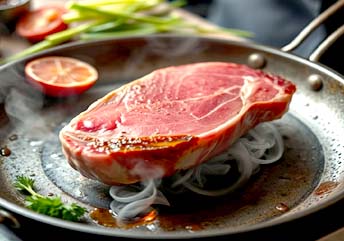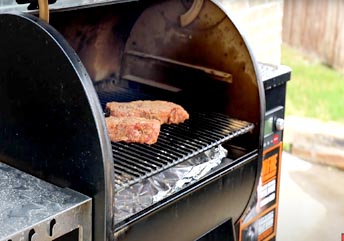Do you ever cut into a steak and see a grey, overcooked ring? The inside might be pink. But the edges are tough and dry. This is a common kitchen problem. There is a simple solution. It is called the reverse sear method. Are you ready to learn how to reverse sear a steak.

The Secret to Perfect Steak
This cooking technique guarantees a perfect steak. The inside will be evenly pink from edge to edge. The outside will have a crispy, flavorful crust. This guide will teach you everything you need to know. We cover ovens, grills, and air fryers. You will learn about times, temperatures, and different steak cuts. Let’s make your next steak the best one ever.
What is a Reverse Sear? Simple Explanation
It is a smart way to cook thick steaks. You cook the steak in two steps. But you do them in reverse order.
First, you cook the steak slowly in a low oven. This gently warms the meat all the way through. Then, you sear it in a very hot pan for a short time. This creates a delicious brown crust.
Think of it like this:
Normally, you sear first and bake second. The reverse sear flips this order. You bake first and sear second. This method gives you more control. It prevents the steak from overcooking at the edges.
Why Reverse Sear? Top 5 Benefits You Get
Why should you try this method? It has many advantages over traditional cooking.
-
Perfect Pink Center. The low heat cooks the steak evenly. You will not get a grey, overcooked ring around the edge.
-
Crispier Crust. The slow oven dries the steak’s surface. A dry surface sears much better than a wet one. You get a darker, tastier crust.
-
Foolproof Results. You use a meat thermometer. This tells you the exact temperature inside the steak. No more guessing if it is done.
-
Great for Thick Steaks. This is the best way to cook a thick cut like a tomahawk or ribeye. The inside cooks without burning the outside.
-
Renders Fat Beautifully. The slow heat melts the fat in steaks like ribeye. This makes the steak incredibly juicy and flavorful.
Essential Tools for Reverse Searing
You only need a few simple tools. Having the right tools makes the process easy.
-
Digital Meat Thermometer. This is the most important tool. It guarantees your steak is cooked perfectly. Do not try this without one.
-
Cast Iron Skillet. A heavy pan like cast iron gets very hot. It holds the heat well. This is perfect for creating a great sear.
-
Oven-Safe Wire Rack and Baking Sheet. The rack lifts the steak up. Hot air can circulate all around it. This helps it cook evenly.
-
Tongs. You need these for handling the hot steak safely.
-
Paper Towels. Use these to pat the steak dry before cooking.
Reverse Sear Time and Temperature Master Chart
This chart is your best friend. It shows the exact temperatures and times you need. Remember, all ovens are different. Always use your thermometer.
Steak Thickness |
Oven Temperature |
Pull Steak Out At |
Final Temp (After Searing) |
|---|---|---|---|
| 1 inch | 275°F (135°C) | 115°F (46°C) | 130°F (54°C) – Medium Rare |
| 1.5 inch | 275°F (135°C) | 120°F (49°C) | 135°F (57°C) – Medium Rare |
| 2 inch (Tomahawk) | 275°F (135°C) | 120°F (49°C) | 135°F (57°C) – Medium Rare |
Why pull the steak out early?
The steak continues to cook after it leaves the oven. This is called “carryover cooking.” The hot sear also adds more heat. Pulling it out early stops it from overcooking.
Step-by-Step: How to Reverse Sear a Steak in the Oven
Follow these steps for a perfect steak every time.
Step 1: Prepare and Dry the Steak.
Take your steak out of the fridge. Pat it completely dry with paper towels. Moisture is the enemy of a good crust. A dry steak will sear beautifully.
Step 2: Season the Steak.
Sprinkle a generous amount of salt and pepper on all sides. The seasoning will stick to the dry surface. You can also use garlic powder or your favorite steak seasoning.
Step 3: The Low and Slow Oven Phase.
Preheat your oven to 275°F (135°C). Place the steak on the wire rack. Put the rack on the baking sheet. Insert your meat thermometer into the thickest part of the steak. Cook until the temperature is 10-15°F below your target.
Step 4: The Blazing Hot Sear.
When the steak is nearly ready, heat your cast iron skillet. Use high heat. Add a little avocado oil or canola oil. Wait until the oil is shimmering and smoking. Carefully place the steak in the pan. It should sizzle loudly. Sear for 60-90 seconds per side.
Step 5: The Crucial Resting Period.
Move the steak to a clean plate. Do not cut it yet. Let it rest for 5-10 minutes. This allows the juices to spread back throughout the meat. Your steak will be much juicier.
How to Reverse Sear on Different Grills
You can get a wonderful smoky flavor using your grill.
How to Reverse Sear on a Gas or Charcoal Grill.
You need to create two heat zones on your grill.
-
Direct Heat Zone: One side with hot coals or a lit burner.
-
Indirect Heat Zone: The other side with no heat below.
Place the steak on the indirect heat side. Close the grill lid. It acts like an oven. Cook until the steak reaches the target temperature. Then, move it to the direct heat side. Sear it for 60-90 seconds per side.
How to Reverse Sear on a Pellet Grill (Like a Traeger).
Pellet grills are perfect for this. Set the grill to 275°F (135°C). Place the steak directly on the grates. Close the lid. Cook until the steak is almost at temperature. Then, increase the heat to high. Or, finish the sear in a hot cast iron pan on the grill.
How to Reverse Sear in an Air Fryer
An air fryer is a fast and easy tool for the first step.
Preheat your air fryer to 275°F (135°C). Place the seasoned steak in the basket. Make sure there is space for air to flow. Cook until the internal temperature is 10-15°F below your target. The air fryer cooks quickly. So check the temperature often. For the best crust, finish searing the steak in a hot skillet on the stove.
Reverse Searing Every Major Steak Cut
Different steaks have different qualities. Here is how to handle them.
How to Reverse Sear a Ribeye Steak.
Ribeye steak has beautiful fat marbling. The reverse sear is perfect for it. The slow heat melts the fat gently. This makes the steak incredibly juicy. Cook it to at least medium-rare (135°F) to render the fat well.
How to Reverse Sear a Tomahawk Steak.
A tomahawk steak is very thick and has a long bone. It can be tricky to cook. The reverse sear is the best method. The long, slow cook in the oven ensures the center is done. Do not forget to sear the fatty edges of the bone for extra flavor.
How to Reverse Sear a Filet Mignon.
Filet mignon is very tender but lean. The reverse sear method protects it from drying out. It cooks so evenly that it stays tender and moist. You will get a perfect pink center. Be careful not to overcook it.
Guide for New York Strip, Sirloin, and T-Bone Steaks.
These steaks also work great with the reverse sear. Follow the main guide and temperature chart. The T-Bone is like getting two steaks in one. The reverse sear cooks both the strip and the tenderloin sides perfectly.
Pro Tips & Advanced Techniques
Try these tips to make your steak even better.
The Dry-Brine Advantage.
For the best flavor and crust, try dry-brining. Sprinkle salt on the steak. Leave it uncovered in the fridge for a few hours or overnight. This seasons the meat deeply and dries the surface even more.
Using Compound Butters.
Make a flavored butter while your steak rests. Mix soft butter with garlic, herbs, or blue cheese. Place a slice on the hot steak just before serving. It will melt into a delicious sauce.
Common Reverse Sear Mistakes (And How to Fix Them)
Avoid these common errors.
First Mistake: Using a Thin Steak.
The reverse sear is for steaks at least 1 inch thick. Thin steaks will cook too fast. They are better cooked with a very hot, fast sear only.
Second Mistake: Not Preheating the Searing Pan.
Your pan must be extremely hot. If it is not hot enough, the steak will steam instead of sear. Wait until the oil is lightly smoking.
Third Mistake: Skipping the Resting Period.
If you cut the steak immediately, the juices will run out onto the plate. Be patient. Let the steak rest for 5-10 minutes. The wait is worth it for a juicier steak.
Frequently Asked Questions (FAQ) About How to Reverse Sear a Steak
Can you reverse sear a flank steak?
No, we do not recommend it. Flank steak is thin and flat. It is best cooked quickly over very high heat. The reverse sear method is for thick, tender cuts.
What is the best oil for searing steak?
Use an oil with a high smoke point. This means it can get very hot without burning. Avocado oil, canola oil, and grapeseed oil are all excellent choices.
Is reverse sear better than sous vide?
Both are great methods. Reverse sear needs less special equipment. You only need an oven and a pan. Sous vide needs a special machine. Reverse sear also creates a better crust.
How long can the steak sit between the oven and the sear?
You have a window of about 10-15 minutes. You do not need to rush. The steak will stay warm. This is helpful when cooking sides.
Conclusion: Your Next Steak Awaits
You now have all the knowledge to cook an amazing steak. The reverse sear method is simple. But the results are incredible. Remember the key steps: cook low and slow first, then sear hot and fast. Trust your thermometer. Be patient while it rests.
You can do this. Your next steak will be a masterpiece.
Which steak cut are you most excited to reverse sear? Share your choice in the comments below! We love to hear from you.
Expert Sources & Video Demonstrations
First Video
Second Video
Third Video
Fourth Video
Fifth Video
- https://www.seriouseats.com/the-food-lab-complete-guide-to-reverse-searing-roast-beef-turkey-chicken-primes-rib
- https://www.americastestkitchen.com/recipes/10496-reverse-seared-steak
- https://www.foodnetwork.com/how-to/packages/shopping/articles/how-to-reverse-sear-steak
- https://www.bonappetit.com/test-kitchen/common-mistakes/article/what-is-reverse-searing
- https://www.weber.com/US/en/grill-skills/beef/how-to-reverse-sear-a-steak/weber-12839.html
- https://www.traeger.com/blog/how-to-reverse-sear-a-steak
- https://www.bbcgoodfood.com/glossary/reverse-searing-glossary
- https://www.thekitchn.com/how-to-reverse-sear-a-steak-cooking-lessons-from-the-kitchn-220031





